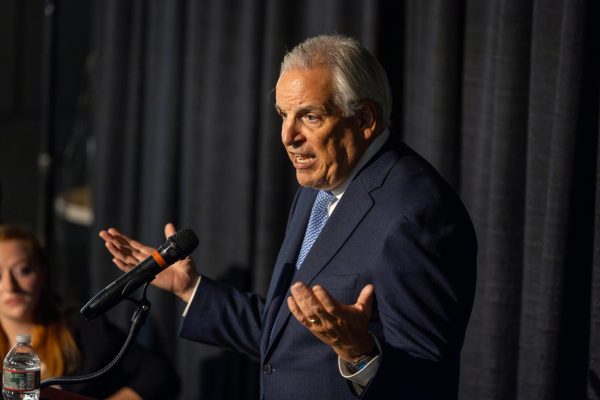The life and legacy of Lucy Hicks Anderson
While black history should and must be celebrated every month of the year, this February, the Sexuality and Gender Alliance (SAGA) is proud to spread the stories of black LGBTQ+ people. The LGBTQ+ population is a richly diverse community; the story below represents a small fraction of many proud, black LGBTQ+ people whose talents and bravery firmly helped them to established themselves as powerful figures in history.
While many people believe that LGBTQ+ identities are a product of modern times, history informs us otherwise. Born in Waddy, Kentucky in 1886 and assigned male at birth, young Lucy Hicks Anderson insisted to her mother that she was not a boy. She was adamant about being recognized and treated as a girl.
The term “transgender” would not be coined until almost a century later, but Lucy was unfazed by this lack of vocabulary to describe her experience. When her mother consulted a physician regarding her identity, the doctor told her that she ought to raise the child as a girl. The child transitioned as she entered school, wearing dresses to class and introducing herself as Lucy.
Lucy left school when she was 15 years old. She began working domestic jobs in order to support herself before moving to New Mexico in her 20s. There she met and married her first husband Clarence Hicks, with whom she moved to Oxnard, California and opened a brothel that would act as a front for her Prohibition-era speakeasy. In Oxnard, Lucy established herself as a respected socialite, known for her extravagant dinner parties and charitable nature.
She and Clarence divorced in 1929. Lucy continued to run her businesses alone, though not unhappily, until she married army soldier Reuben Anderson in 1944. During World War II, she purchased over $50,000 in war bonds, threw lavish send-off parties for local enlisted men preparing to leave for combat and would personally meet with grieving families of local deceased soldiers to comfort them in their times of need.
Though Oxnard was segregated under American law at the time, Lucy remained undaunted, befriending black and white socialites alike. She was extremely well-liked by the people of Oxnard.
“When the sheriff arrested her one night, her double-barreled reputation paid off. Charles Donlon, the town’s leading banker, promptly bailed her out [because] he had scheduled a huge dinner party which would have collapsed dismally with Lucy in jail,” said transgender scholar and activist C. Riley Snorton in his book, “Black on Both Sides: A Racial History of Trans Identity.”
However, trouble found Lucy in 1945 when a patron from her brothel claimed to have caught a venereal disease there. In response, local doctor Hillary R. Morgan demanded every woman in the brothel be examined. This included Lucy, who had never participated in the sex work herself. It was during this pelvic exam when she was outed as transgender.
The Oxnard community she had loved so much turned against her and offered her no support as the Ventura County district attorney tried her for perjury. She was accused of falsifying her marriage documents on account of her sex and therefore falsely claiming her husband’s G.I. benefits.
Lucy stuck to her guns, even while forced to stand trial. She asserted her womanhood before the jury and testified that she’d lived her entire life as a real woman and that her sex indicated nothing about her identity.
Head held high, she proclaimed, “I defy any doctor in the world to prove that I am not a woman. I have lived, dressed and acted just what I am, a woman.”
This truth was disregarded, however, and she and her husband were imprisoned after their marriage was nullified by the court, with an additional 10 years of probation following the jail time. Lucy was sent to Leavenworth Penitentiary and was forbidden from wearing women’s clothing during her sentence. She and Reuben attempted to return to her beloved Oxnard upon their release, but were forbidden to settle by the Chief of Police, who threatened to arrest them both. The couple moved to Los Angeles and lived there quietly until Lucy’s death in 1954. She was 68 years old.
Lucy Hicks Anderson was an early pillar of the community in an era where her identities — black, trans, and female — were and still are under attack by society at large. The three-headed snake of racism, misogyny and transphobia that Lucy battled throughout her life continues to strike today with fatal consequences. According to the Human Rights Campaign, over 20 American black transgender women were murdered in 2019, an extension of an ongoing epidemic of violence toward black transfeminine people.
The oppression that plagued Lucy’s rich life is still very much alive and well today. It is the responsibility of allies and activists alike to boost and defend black LGBTQ+ voices every day of the year.
We invite The Hawks’ Herald readers to learn more about anti-racist activism and allyship by seeking out anti-racist literature. For a good starting point, we suggest “Me and White Supremacy: Combat Racism, Change The World, and Become a Good Ancestor” by Layla F. Saad and “White Fragility: Why It’s So Hard for White People to Talk about Racism” by Robin DiAngelo.
Being a good ally is an ever-evolving process. Becoming familiar with anti-racist text is a great way to begin the process of unlearning bigoted thoughts and patterns, not just during Black History Month, but every month of the year.





